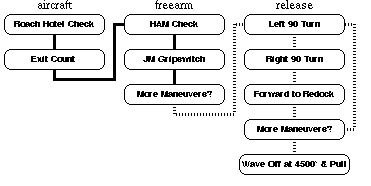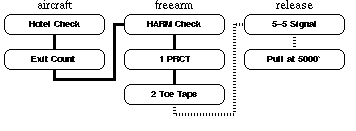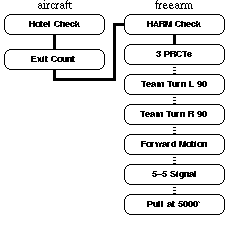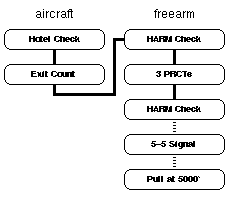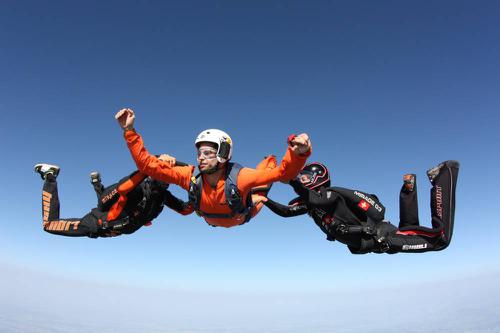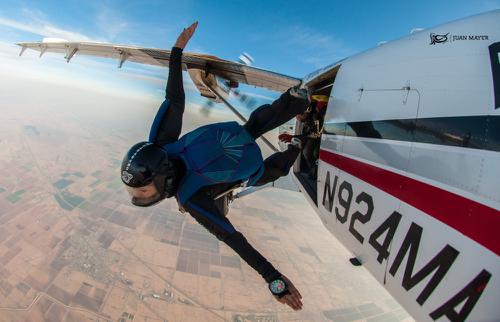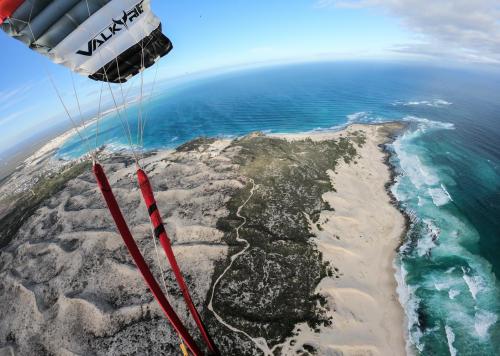Will Penny and Johannes Bergfors Want to Take You Places
First, let’s get one thing straight: Johannes Bergfors and Will Penny don’t necessarily have, like, a problem with tent camping, beer trucks and zoo loads. They like that stuff just fine -- they just do things a little differently, is all. And they do them differently in very interesting places.
Will and Johannes met at a FlajFlaj event in California a few years ago. Johannes’ video chops attracted Will’s attention. Will invited him to Paradise Portugal to film him and his Flynamic teammate, Yohann Aby, as they trained for the World Championships.
“I’d never been in a [skydiving] team,” Johannes muses, “And I was interested in how a team at that level went into the training process.”
True to eager form, Johannes didn’t just film the jumps. He started bringing the camera into the teammates’ daily lives and started interviewing them incisively about their process. He made a documentary about it. (It’s called Work. It’s great. You should watch it.)
As you might imagine, Johannes and Will worked really well together, right off the bat, and the scope was bound to expand sooner-or-later. That flashpoint moment came along when Johannes saw a photo of a beautiful beach dropzone in Kenya.
“It was beautiful,” he remembers, “And I wanted to organize an event there because I was pretty sure it was the only way I was going to be able to go.”
Up until that point, Johannes had been hired by lots of other events as a videographer and coach. He’d even organized “some smaller stuff” in his native Sweden. Along the way, he’d seen what had been done well and poorly. He knew for certain that he needed a co-organizer to pull it off; Will, with their established rapport and Will’s deep connections in skydiving, was the natural choice. Since he’s a South African with extensive connections around the rest of the continent and parents in the hospitality industry, Will had even more vital bona fides for the task -- and, happily, he was keen.
The pair kept the first event intentionally small -- a beta test, right-sized for a home run. Participants stayed together in a beachside villa, steps from the dropzone. The skydiving was calibrated to be decidedly quality-over-quantity. A top-shelf chef was on-hand to cook every meal. (Johannes was once a chef himself, so he knows a thing or two about that.) They called it “Skyfari”: a nod to its African venue, for certain, but also to its emphasis on exploration over logbook-stuffing.
Unsurprisingly, the event nailed its goals. There were already plans being made for the next one by the time the first one wrapped.
“These are all all inclusive events,” Johannes explains, “where we are focusing on giving inspiring experiences to participants. That is something we are super grateful to be able to do.”
Since that first Kenyan foray, Will and Johannes have done four other events in this style. The first three shared the Skyfari name; the fourth and fifth, held on Will’s home turf, the southernmost point of South Africa, was called Skydive South Africa: Southern Tip. (Hashtag: #justthetip. Of course.)
For a little descriptive flavor: the Southern Tip event was a pop-up drop zone in the picturesque little Afrikaaner hamlet of Arniston, where Will’s family connections to hospitality are strong.
“It is not a place you drive through,” Johannes explains. “It’s a special place, especially for Will, because as he was growing up, when his parents were working in tourism, they traveled around Africa and lived in different places, but they always had their house in Arniston as a getaway. They would go there for the weekend and spend time there and just enjoy this little gem of a place.”
“It is also a very special place in the world for many reasons,” he continues, “Did you know that Table Mountain alone has a larger variety of plants than all of Great Britain? The Western Cape plant kingdom takes up the area of ½ a percent of the African continent but it hosts 20% of the species. All of that is mind-blowing to me. On these events, we fill the days with extracurricular activities to enjoy what’s special about the places we travel to. Our participants are really into it.”
The event logistics, of course, look very different than those of a standard boogie. For Arniston, for example, the event took advantage of a cute little dirt-strip airfield. They brought in a 206, a pilot and ground crew. There were six participants, making a ratio of 1.75 staff to each participant. Accommodation-wise, the event rented a beautiful two-level villa with sweeping sea views from almost every room, facing the sunrise every morning. A private chef cooked for the group three times a day.
When the group wasn’t jumping onto the most pristine beach of Arniston, they were marauding around the Western Cape with great big smiles on. They went surfing; out for dinner a few times; out-and-about in Cape Town. On one memorable morning, they went horseback riding together on an empty beach. After they cavorted down the beach for an hour or so, they took the saddles off the horses and swam with them. Magic.
“It is all inclusive from the moment they arrive until they leave,” Johannes notes. “All the experiences are included. Because the conditions in a situation like this are very hard to guess ahead-of-time, we don’t stipulate a certain amount of included jumps -- we say you are going to do up to 8 jumps, but it is not decided if we are going to 6, or 5, or 2, because we cannot guarantee it.”
“We also tell the participants they have to be ready to go at any time,” Johannes adds. “Because we have a very small margin to play with in terms of weather, airspace limitations and surrounding logistics. We have to be dynamic in decision making. We are constantly armed in the sense that when all of the parameters are on our side, then we are going to strike. As a jumper in that situation, you have to be ready all the time. We are super transparent with all this and explain this very well to the participants, because in a group this small, everybody’s buy-in really matters. And we get it.”
To roll with those variables, Skyfari participants can’t be fresh off the AFF boat. The event requires each jumper to have at least 500 jumps -- and, on account of the inn-hopps, at least 50 jumps on the canopy they’re flying. Due to the group’s small size, Will and Johannes are able to flex their strategy to fit.
“The last time it was quite an experienced group; this time a bit less experienced,” Johannes says. “We adjusted our plan. In general, the beaches around Arniston are quite long and wide, but they are super windy. We can’t $&*% up because there are sharks in the water.”
These days, Will and Johannes are expanding their horizons yet again. They’re heading to the Maldives for the next one -- and launching an educational project called High School together (an extensive, professional post-jump-course education targeted to the jumper with 20-500 jumps who’s looking to find and fill skills and knowledge gaps). For these two, it’s all about going places -- in the world, in your sports and in your own personal scope -- and the thing they want most is a cadre of keen fellow adventurers along for the ride.
Take it from Skyfari participant David Beneviste, who has done two events so far:
“The group and the chemistry we had were incredible,” David says. “We were laughing all the time. And it was an adventure! The more I get to know Will and Johannes, the more I want to go travel with them. Whenever I can swing it, I will certainly do it again.”
Curious about participating in an upcoming event? Check out https://www.johannesbergfors.com/events for more details.

